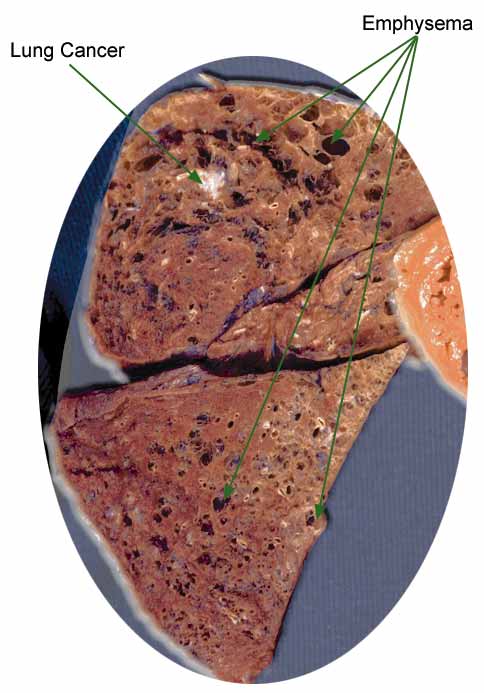Fractal Applications
Fractal MedicineModern medicine often involves examining systems in the body to determine if something is malfunctioning. Since the body is full of fractals, we can use fractal math to quantify, describe, diagnose and perhaps soon to help cure diseases. A cross-section of a lung showing both emphysema and lung cancer. Image courtesy of the University of Iowa. With modern imaging equipment such as CT scans and MRI machines, doctors can have access to a huge amount of digital data about a patient. Making sense of all the data can be time-consuming and difficult even for trained experts. Teaching computers to use mathematical processes to tell the difference between healthy lungs and lungs suffering from emphysema promises to help
make faster, more reliable diagnoses. The fractal dimension of the lung appears to vary between healthy and sick lungs, potentially aiding in the automated detection of the
disease.REF
 A schematic diagram of normal blood vessels, abnormal tumorous blood vessels, 'renormalized' blood vessels, and inadequately space-filling blood vessels. Image courtesy of Edwin L. Steele Laboratory, Harvard.
Cancer is another disease where fractal analysis may not only help diagnose but also perhaps help treat the condition. It is well known that cancerous tumors - abnormal, rapid growth
of cells - often have a characteristic growth of new blood vessels that form a tangled mess instead of the neat, orderly fractal network of healthy blood vessells.
Not only can these malfunctioning vessels directly harm the tissue, but they can also make it harder to treat the disease by preventing drugs from reaching into the inner parts of tumors
where the drugs are most needed.
Fractal analysis of cancer may be applied in many avenues. To quote Dr. Larry Norton, a cancer researcher at Memorial Sloan Kettering Cancer Center, '"Tumors have a higher fractal dimension than normal tissues indicating their greater internal complexity." Norton noted that fractal dimensions have a tremendous buffering capacity, in that they grow in value even as the tumors themselves change little in terms of their apparent size. But once the dimension reaches a threshold value, the system changes radically, much as a ball traveling across a table drops when it reaches the edge. "That's what happens with cancer," he explained. "People can go out and smoke and not have cancer and then suddenly they do. We're talking here about the power constants of the fractal dimensions - one incremental change gets them in trouble. Imagine if we understood the genes that control that power function. If we could understand those molecular changes, we might have a whole new target for intervention." ' REF
|
|
<- PREVIOUS NEXT -> © Fractal Foundation. |